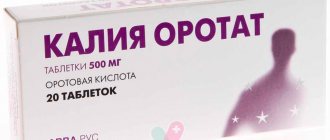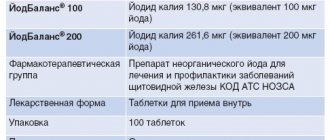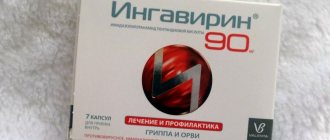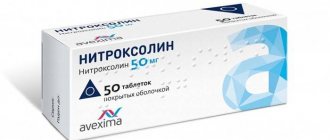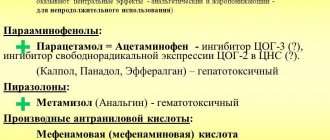Treatment of a runny nose Medicines
The antiviral drug "Ingavirin" is based on an active substance that was invented in the 70s of the last century with the aim of using its ability to combat cancer. For the first time, a previously unknown dicarbamine was synthesized, capable of stimulating the process of production of leukocytes in various forms. This quality has been actively used in complex therapy of oncology, against the background of the use of chemotherapy and radiological irradiation. Throughout the clinical use of the substance, active work has been carried out to study its properties and spheres of influence on the human body. The scientific research was carried out by the doctor who first synthesized dicarbamine, A. Chuchalin.
In 2005, based on the obtained clinical studies, a practical test of the substance was carried out in the treatment of viral pathologies. In 2009, a new antiviral drug, Ingavirin, went on sale in the pharmacy chain and was widely used in the fight against one of the most powerful influenza epidemics. During the course of prescription by doctors, it was found that this drug reduces the long hyperthermic period by almost 2 times, reduces the catarrhal manifestations of colds and flu and eliminates the risk of complications.
Due to the existing history of clinical trials over 40 years, we can say with confidence that specialists know for certain all the pharmacological properties, contraindications and dosage of this substance. In this article you can learn about how to take Ingavirin for colds, flu and for the purpose of their prevention during seasonal epidemics.
Release form and composition
Ingavirin is released in a single form - capsules with the company logo “I”. Inside the capsules there are white granules. The active ingredient is pentanedioic acid imidazolylethanamide (vitaglutam). Depending on its quantity, the medicine is produced in 3 forms:
- 30 mg: capsule color - blue, one package contains 1 or 2 blisters, respectively, 7 and 14 units. Additional components for the shell: titanium dioxide, gelatin, azorubine, dye - black diamond, crimson black 4R, patent blue.
- 60 mg: color - yellow, packaging - 1 blister. Auxiliary coating composition: titanium dioxide, gelatin, yellow iron oxide (dye).
- 90 mg: red tone, packaged in 7 pieces. Other shell ingredients: titanium dioxide, gelatin, quinoline yellow, crimson 4R, azorubine.
Common components of granules:
- lactose monohydrate;
- magnesium stearate;
- potato starch;
- Aerosil (colloidal silicon dioxide).
The logo is applied with substances that are harmless to the body - titanium dioxide, shellac, propylene glycol.
Bronchodilators
Solution for inhalation
Salbutamol is a drug that dilates small bronchi. It can be used for chronic bronchitis, as well as for acute bronchitis in children, accompanied by bronchospasm. The drug is contraindicated in children under 2 years of age, as well as in cases of pregnancy. It can be used with caution during normal pregnancy and during breastfeeding. Side effects are associated with the effect of salbutamol on beta-adrenergic receptors located in other organs. Sometimes there is an accelerated heartbeat, muscle tremors, and headache.
Salbutamol is part of metered-dose aerosols for inhalation: Astalin, Ventolin, Salamol Eco. In addition, it is available in the form of solutions for nebulizer therapy, especially often used in children: Ventolin Nebula, Salamol Steri-Neb, Salgim. There are also Salbutabs extended-release tablets used for chronic bronchitis.
Salbutamol is a component of combination drugs such as Berodual. Berodual is available in the form of an aerosol for inhalation and a solution for a nebulizer. This drug is used for acute bronchospasm in children, severe chronic bronchitis with bronchial obstruction. In addition to salbutamol, it contains ipratropium bromide, which has a similar effect.
The most common side effects of the drug are cough, headache, dry mouth, muscle tremors, palpitations, rapid heartbeat, nausea and vomiting, increased blood pressure, allergic reactions and paradoxical bronchospasm. Berodual is contraindicated in certain heart diseases, arrhythmias, and in the 1st and 3rd trimesters of pregnancy. Use it with great caution in children under 6 years of age.
Bronchodilator therapy is prescribed only by a doctor. When carrying out inhalations using a nebulizer, their rules should be strictly followed. Exceeding the dose or frequency of inhalations is unacceptable. If the condition of a child or adult patient worsens after using bronchodilators, you should immediately consult a doctor.
pharmachologic effect
The product strengthens cellular immunity by increasing the number of cells that damage the structure of the viral pathogen. In addition, the production of cytotoxic lymphocytes is stimulated. Thanks to this, the following actions are carried out:
- the duration of the febrile state is reduced;
- the formation of cytokines is suppressed;
- the effect of myeloperoxidase is reduced;
- has an antiviral effect;
- the level of the inflammatory process decreases;
- catarrhal symptoms are eliminated (pain in the throat, nasal congestion, lacrimation, cough);
- the severity of the intoxicating effect decreases - weakness, drowsiness, fatigue, headache;
- the immune system is strengthened;
- body temperature is restored;
- the risk of complications is reduced.
Pharmacodynamics
The drug actively fights against many pathogens of respiratory and other diseases - influenza B and A viruses, adenoviruses, rotaviruses, parainfluenza, sentitial infections, coronavirus, enterovirus, Coxsackie pathogen, rhinoviruses. Therefore, Ingavirin is prescribed for influenza, sore throat, ARVI and similar pathological conditions.
The mechanism of action of the active substance is based on stimulation of parts of the immune system that are responsible for suppressing viral proteins at the cellular level. After long-term studies, it has been proven that vitaglutam helps to increase the expression of interferon receptors (type 1 IFNAR) on immunocompetent and epithelial cell surfaces. Increased receptor density increases the sensitivity of cells to endogenous interferon. In this process, the transmitter protein STAT1 is phosphorylated (activated), which transmits signals to the cell nucleus, after which antiviral genes are induced.
In addition, the synthesis of MxA (effector antiviral protein) is activated, which inhibits the intracellular transport of viral ribonucleoproteins, as a result of which the process of viral replication slows down. Due to the increase in the concentration of interferon in the blood fluid, the interferon-a and -γ producing ability of leukocytes is restored. Against this background, cytotoxic lymphocytes are generated, the number of NK-T cells, which have a high degree of killer activity towards the affected cells, increases. Thus, the necrosis factor TNF-α, interleukins IL-1β and IL-6, and myeloproxidase are suppressed.
The drug has a low level of toxicity, increases the effectiveness of antibiotics, and is considered safe. This has been proven by experimental studies.
Pharmacokinetics
Pharmacokinetic features:
- Level of absorption and distribution of the active substance. To identify these factors, radioactive tags were used, thanks to which it was determined that the drug was evenly distributed throughout the internal systems and was quickly absorbed into the blood after entering the gastrointestinal tract. The maximum plasma concentration is observed half an hour after taking the capsules. The substance remains in the blood for approximately 36-37 hours with a single dose. If the patient undergoes a course of therapy, the concentration of the substance increases 30-60 minutes after administration, and decreases slowly throughout the day.
- Metabolization and excretion. Metabolism does not occur in the body, so the active substance is completely eliminated within a day, unchanged. Over a maximum of 5 hours, 35% is released. Release is 77% through feces and 23% through urine.
Mucoregulators
Drugs in this group thin mucus and improve coughing. The most commonly used products are those based on bromhexine and ambroxol.
Bromhexine
Popular remedy
Bromhexine thins mucus and helps cough it up. It is prescribed in the presence of viscous, difficult to cough up sputum in tracheobronchitis, chronic bronchitis, broncho-obstructive syndrome in children.
The drug is approved for use in children, adults, pregnant and lactating women (after consultation with a doctor). It is contraindicated in case of individual intolerance. Side effects include stomach pain, headache, urticaria, and sometimes increased cough and bronchospasm.
Bromhexine is included in the following drugs: Bronchostop, Solvin, Bromhexine. It is available in the form of tablets, drops, and oral solution. Bromhexine is also included in complex drugs for the treatment of bronchitis: Ascoril, Bronchosan, Joset, Cashnol, Cofasma.
Ambroxol
This substance changes the ratio of sputum components, reducing its density and improving coughing. It improves mucociliary transport, that is, the work of the epithelial cilia, which remove mucus into the trachea. The product slightly reduces the severity of cough.
Ambroxol is used for acute and chronic bronchitis in children of any age, adults, pregnant women in the 2nd and 3rd trimesters. There are forms for use in a nebulizer.
The drug is contraindicated during breastfeeding, in the 1st trimester of pregnancy, gastric and duodenal ulcers, and convulsive syndrome. Side effects are rare: abdominal pain, nausea and vomiting, loose stools, headache, weakness, allergic reactions.
The dose of the drug for children must be determined by a doctor, taking into account the age and weight of the child.
Ambroxol can be taken simultaneously with antibiotics, it improves their effect.
This substance is part of the following drugs: Ambrobene (there is a solution for inhalation), Ambrohexal (there is a solution for inhalation), Ambrolor, Ambrosan, Bronkhoxol, Bronchorus, Lazolvan (there is a solution for inhalation), Lazongin (lozenges), Medox, Neo -Bronchol (lozenges), Remebrox, Suprima-Kof, Thoraxol Solution Tablets, Flavamed, Halixol.
Ambroxol is part of multicomponent drugs: Codelac Broncho, Coldact Broncho.
Indications for use
The drug is prescribed for the prevention and treatment of the following diseases:
- influenza (type A, B):
- ARVI;
- adenovirus;
- rotavirus;
- parainfluenza;
- respiratory pathologies.
Ingavirin for prevention
Thanks to vitaglutam, the level of interferon increases, as a result of which the immune system is strengthened, therefore Ingavirin is actively used for preventive purposes. To put it simply, interferon protein makes the body immune to virus attack. It is recommended to take the product 7-10 days before an epidemic outbreak, but effectiveness is observed even after contact with an infected person. For preventive purposes, Ingavirin is taken as follows:
- The daily requirement for an adult is 90 mg, that is, one capsule per day with a concentration of 90 mg or 1 unit (30 mg) three times a day. Duration - a week.
- Children need to take 60 mg per day.
Ingavirin for flu
To increase the effectiveness of influenza treatment, it is recommended to take Ingavirin immediately after the appearance of primary symptoms, but no later than 36 hours. If you take it later, it will take longer to achieve a powerful therapeutic result. Capsules are taken orally with water; they should not be chewed. Therapy rules:
- An adult should take 90 mg per day.
- For a child over 13 years of age, it is enough to drink 60 mg once a day.
- The duration of therapy is at least 5 days, depending on the severity of the disease.
Ingavirin for rotavirus
Rotavirus infection is an acute intestinal disease that occurs against the background of a viral infection, so Ingavirin is prescribed in this case as well. It is recommended to take the drug 1 unit per day for a week. The dosage depends on age: adults - 90 mg, children - 30-60 mg. Along with Ingavirin, it is necessary to use other drugs: Derinat, Cycloferon, Arbidol.
Antiviral drugs
These medications are effective if you start treatment with them in the first two days of the disease. Let's consider those that are best studied and recommended today for the treatment of viral respiratory tract infections.
Ingavirin
This drug directly inhibits the formation of viruses and stimulates antiviral immunity against influenza A (including swine), influenza B, and other infections. In addition, the medicine modulates the production of interferons (protective substances) and immune system cells, allowing the body to cope with the disease.
Ingavirin's analogues
The drug does not have a negative effect on the central nervous system, so psychomotor reactions are not inhibited. Therefore, it can be drunk by drivers and people whose professional activities involve increased concentration. The drug has a minimal list of contraindications and only one side reaction, so in rare cases it is replaced with a similar medication. However, analogues exist - both more expensive and cheaper. They may have the same or different composition and mechanism of action.
Which is better: Ingavirin or Kagocel?
Kagocel is based on the active substance of the same name, which is of plant origin. It is synthesized from a yellow pigment in cotton plants called gossypol. Ingavirin is based on vitaglutam, a derivative of the animal world (synthesized from the biogenic amine histamine). Thus, when pentandic acid was combined with histamine, a unique chemical compound was obtained.
Features of the two drugs:
- Both are produced in the Russian Federation.
- Kagocel is produced in tablet form, Ingavirin is produced in capsule form.
- The first remedy is approved for use from 3 years of age, the second - from 13 years of age.
- Kagocel is additionally prescribed for herpes infection.
- The composition of the excipients is identical.
- Both drugs are non-toxic.
Which is better: Ingavirin or Amiksin?
Amiksin contains the active substance tiloron, Ingavirin contains vitaglutam, but their mechanism of action is the same - the production of interferon is stimulated. The analogue has a wider range of indications: in addition to viral diseases, it is used to treat tuberculosis, chlamydia, herpes, encephalomyelitis, and hepatitis. It is used from the age of 7 (Ingavirin - from the age of 13), but causes more adverse reactions. And the cost of Amiksin is higher.
Which is better: Ingavirin or Ergoferon?
The drugs belong to the same antiviral group, but have the following differences:
- Ergoferon is based on interferons, therefore it has a large list of indications. In addition to influenza and ARVI, it is used for the treatment and prevention of pneumonia, hemorrhage, chicken pox and any bacterial infection. This is a homeopathic remedy with antiviral and antibacterial effects.
- Ergoferon is available in the form of tablets and powdered mass for the preparation of suspensions. Ingavirin is produced only in capsule form.
- The first drug for preventive purposes must be taken for a month to six months, the second - for a week.
- Ingavirin is used from 13 years of age, Ergoferon - from 3 months. In many cases, it is prescribed even during pregnancy and lactation.
- The price of the analogue is higher.
Which is better: Ingavirin or Cycloferon?
These are not structural analogues with different compositions: Ingavirin has the active substance vitaglutam, Cycloferon has liniment. The pharmacological groups and the mechanism of influence also differ. Peculiarities:
- Cycloferon is a synthetic interferon inducer. Consequently, the drug helps stimulate the synthesis of interferon in the body, which leads to the production of elements that resist viruses. For this reason, the range of applications is quite wide. In addition to viral respiratory diseases, it is prescribed for hepatitis, rheumatoid arthritis, and HIV.
- Ingavirin acts directly on the pathogen, therefore it is used less frequently than its analogue. Moreover, the drug is prescribed only from the age of 13, and Cycloferon - from the age of 4. But the cost of both drugs is almost the same.
Which is better: Ingavirin or Arbidol?
Arbidol is based on umifenovir, which does not allow the lipid membranes of the virus to stick to the cell membranes of the body, thereby stopping the vital activity of the pathogen. The active ingredient Ingavirin increases the sensitivity of cells to interferon, strengthening the immune system. Based on this, it can be stated that the mechanism of action of the drugs is different.
Arbidol is recommended for use from 2 years of age, Ingavirin - from 13 years old, the indications for treatment are almost the same (Arbidol is additionally used to strengthen the immune system after surgery, for herpes, and immunodeficiency). The course of treatment with Ingavirin is 7 days, with Arbidol - longer (depending on the purpose and severity of the disease).
Which is better: Ingavirin or Remantadine?
Rimantadine is based on rimantadine hydrochloride, which is a powerful antiviral substance and is increasingly popular due to the rapid achievement of a therapeutic effect. If you compare both drugs, they are identical. But the difference is only in the composition and form of release (Remantadine is produced in capsules and tablets, Ingavirin is mainly in capsulated form). The means are interchangeable.
Which is better: Ingavirin or Tamiflu?
Tamiflu is based on oseltamivir, Ingavirin is based on vitaglutam. The cost of the former is higher, but the list of indications for use is much smaller. Tamiflu is used exclusively for influenza conditions, Ingavirin fights many viruses. The peculiarity of the analogue is that the active substance blocks the removal of affected elements from cells, thereby eliminating complications on the respiratory system. This drug is considered absolutely harmless, therefore it is prescribed starting from the 1st year. Ingavirin not only has a detrimental effect on viruses, but also strengthens the immune system and reduces the level of inflammation.
Which is better: Ingavirin or Trecrezan?
Trecrezan is an immunomodulator with adaptogenic action, therefore it is used for diseases associated with a decrease in the level of defense of the immune system. To put it simply, the drug does not suppress viruses, but strengthens the immune system, due to which the body begins an active fight against viral and other pathogens. In addition, physical and mental activity increases, immune status is corrected, the negative effects of toxins and oxygen starvation in the brain are reduced.
Based on the above, the drugs are not structural analogues, but both drugs are actively used for respiratory diseases as immunomodulators. Ingavirin additionally suppresses viruses. The price of the latter is almost 2 times higher.
Which is better: Ingavirin or Lavomax?
The drugs are included in a single antiviral group, but have different compositions. Ingavirin is imidazolylethanamide of pentanedioic acid, Lavomax is tilorone dihydrochloride, which, in addition to suppressing viruses, has a positive effect on neoplasms, inflammation, and high fever. Lavomax was developed more than 50 years ago, so it is very popular, especially in European countries. In addition, it is used not only for ARVI, influenza and other viral pathologies, but also for the treatment of all types of hepatitis, CMV, and herpes. Otherwise, the drugs are identical, down to the cost.
Which is better: Ingavirin or Polyoxidonium?
Polyoxidonium contains azoximer bromide, which is an antioxidant and has anti-inflammatory, immunomodulatory and detoxifying effects. This indicates that the body produces antibodies to viruses, activates immune cells, removes toxic compounds, and restores cell structure. Ingavirin relieves inflammation, suppresses viruses, synthesizes interferon, strengthening the immune system.
Polyoxidonium has a wide range of uses - influenza, ARVI, allergies, diseases of the ENT organs, infection with bacteria, fungi, herpes, tubercle bacilli. Ingavirin is produced only in capsule form. Polyoxidonium - in the form of tablets, vaginal and rectal suppositories, lyophilisate.
Which is better: Ingavirin or Tsitovir?
Cytovir contains bendazole, thymogen and ascorbic acid, and is a powerful immunomodulator with complex effects. The drug is aimed at destroying various viruses and reducing the inflammatory process. Therefore, it is used to combat respiratory pathogens, like Ingavirin. Produced in powder form for the preparation of suspensions and tablets. Prescribed from the age of one (Ingavirin is available in capsules, used after 13 years).
Cytovir is contraindicated in patients with diabetes mellitus and pregnant women. If we talk about side reactions, Ingavirin can in rare cases cause an allergic reaction, and Tsitovir also increases blood pressure.
Which is better: Ingavirin or Ibuklin?
Ibuklin refers to a combination medication that is based on 2 active components - ibuprofen (non-steroidal anti-inflammatory effect) and paracetamol (has an analgesic and antipyretic effect). Pentanedioic acid imidazolylethanamide, which is part of Ingavirin, is aimed at destroying viruses and strengthening the immune system. Thus, Ibuklin eliminates inflammatory processes and unpleasant symptoms, and Ingavirin also suppresses the pathogen.
Ibuklin is used not only for colds, but to relieve pain in the teeth, joints, head, etc. The drugs are not structural analogues, therefore they are often prescribed in complex therapy, that is, simultaneously.
Which is better: Ingavirin or Bronchomunal?
Bronchomunal contains lyophilized bacterial lysate, so the product is used for bacterial and viral infections. Additionally prescribed as an immunostimulant. Ingavirin has indications only against respiratory viruses, so the drugs are quite different and cannot fully replace each other.
Anti-inflammatory drugs
When the temperature rises, paracetamol and other non-steroidal drugs can be used. For bronchitis, it is recommended to use a specific drug aimed at the inflammatory reaction in the respiratory tract - fenspiride.
It is part of such syrups and tablets as Siresp, Eladon, Epistat, Erespal, Erispirus. Fenspiride relieves inflammation of the bronchi and reduces their spasm. It is used not only for bronchitis, but also for diseases of the upper respiratory tract, bronchial asthma, otitis media, sinusitis, cough of any etiology.
Fenspiride goes well with antibiotics and is indicated in all cases of bronchitis.
The drug is well tolerated. Only in some patients does it cause abdominal pain, nausea and loose stools.
The drug is not used in pregnant women and breastfeeding. For the treatment of children over 2 years of age, syrup, rather than tablets, should be prescribed.
Instructions for using the medicine for children
Ingavirin is used starting from the age of 13 and mainly in a dosage of the active substance of 30 or 60 mg. This is due to the fact that clinical studies have not yet been conducted, so the safety for the child’s body is unknown.
The main reason for the inappropriateness of conducting research on the influence and effectiveness of a pharmacological agent is the effect of vitaglutam on the circulatory system, since the internal systems of the child’s body are not fully formed.
Rules of application:
- The daily dosage of the drug is a minimum of 30 mg, a maximum of 60.
- Reception is carried out 1 or 2 times a day.
- The duration of the course is from 5 to 7 days.
Antitussives
In the first days of bronchitis, patients complain of a severe dry cough. If it is not accompanied by the formation of sputum, the doctor sometimes prescribes antitussives to suppress it. Codeine medications, such as Terpincode, suppress cough very quickly. These products are only available with a doctor's prescription. It is often more convenient to use medications that can be purchased without a special prescription, simply as prescribed by a doctor. These include, in particular, prenoxdiazine (Libexin).
The product has a local anesthetic effect, thereby reducing the sensitivity of the bronchi. It dilates the bronchi and slightly depresses the respiratory center.
Libexin is not addictive and does not affect the central nervous system. It can be used in adults and children of any age (with caution), in pregnant and lactating women.
Ingavirin and alcohol
Ingavirin's abstract does not contain direct information regarding the use of the drug along with the consumption of alcoholic beverages. However, medicine does not recommend the simultaneous consumption of alcohol and medicinal forms. This is due to the fact that the active ingredients of medications enter into chemical reactions with ethanol, which provokes adverse reactions. To put it simply, this leads to a significant decrease in the effectiveness of vitaglutam. In addition, alcohol, when interacting with a substance, contributes to the following adverse reactions:
- sleep disturbance;
- intoxication of the body;
- decreased concentration;
- irritability;
- headache;
- exacerbation of chronic pathologies;
- loss of consciousness;
- internal bleeding (if there are problems with the circulatory system).
In order for the drug to be completely eliminated from the body during a course of treatment, it is necessary to wait at least 3 days. Only after this time is alcohol consumption allowed.
Mucolytics
Agents that thin mucus and remove it from the bronchi are called mucolytics. The most common of them are acetylcysteine and carbocysteine.
Acetylcysteine makes sputum more liquid and increases its quantity, making it easier to cough up. It can be taken for any bronchitis by children, adults, pregnant women, or breastfeeding women after consulting a doctor. But it is advisable not to use mucolytics in children under 3 years of age, because at that age they cannot cough well. When using acetylcysteine in children, percussion chest massage is indicated.
It is better to take acetylcysteine not simultaneously with antibiotics, but after two hours. You can use special forms for inhalation through a nebulizer.
The drug only sometimes causes undesirable effects: nausea, urticaria, nosebleeds. When used inhalation, a reflex increase in bronchospasm is possible.
The drug is contraindicated in case of exacerbation of gastric and duodenal ulcers, pulmonary hemorrhage and hemoptysis, individual intolerance.
A doctor will help you choose medications
Acetylcysteine is included in the following products: Acestine, ACC, Vicks Active Expectomed, Fluimucil (there is a solution for inhalation).
Carbocysteine has very similar properties to acetylcysteine. It is contraindicated in the 1st trimester of pregnancy, as well as during exacerbations of chronic glomerulonephritis. Carbocisteine is included in the following drugs: Bronchobos, Libexin Muco, Fluifort, Fluditek.
Side effects
With rare exceptions, an allergy to the active substance or auxiliary components is possible. No other side effects have been identified, the medicine is easily absorbed by both adults and children.
Ingavirin does not affect psychomotor reactions and does not have a sedative effect. Can be prescribed to people with work that requires increased concentration. No studies have been conducted on the ability to drive a car, but given the absence of side effects and sedative effects, taking the drug will not affect the quality of driving.
Treatment of children
No research has been carried out regarding the possibility of using Ingavirin in the treatment of children. From which it follows that its effect on the child’s body has not been studied. Therefore, it is not recommended for a child to take the drug.
It is worth noting that the history of the drug began quite a long time ago, and there are serious reasons indicating that it is better not to use this drug in the treatment of children. The medicine was registered and went on sale as an effective remedy against influenza viruses only in 2008, but its production began in the seventies.
After its development in the 70s, the drug was prescribed to stimulate the circulatory system in people undergoing chemotherapy for the treatment of cancer.
The drug is still used in oncological therapy today, but here it has a different name and contains a larger amount of vitaglutam - Dicarbamine.
Therefore, we can conclude that Ingavirin affects hematopoietic processes, and this can cause negative reactions in the child’s body. A child’s regulatory systems are less stable than those of an adult; as a result, any interference in their work can cause a sharp deterioration in health and even lead to the development of serious illnesses. Therefore, it is prohibited for children under eighteen years of age to take Ingavirin.
Children's medicines are considered to be drugs that are not dangerous to the child's body, such as Anaferon, Arbidol and others.
Contraindications
Not all people without exception are allowed to use Ingavirin; there are a number of conditions when the use of capsules is strictly prohibited.
Contraindications to the use of Ingavirin:
- children under 18 years of age;
- pregnancy;
- personal intolerance to any of the components contained in the drug;
- functional disorders of the liver, kidneys, severe nature of the course.
If you have one of these contraindications, you cannot use Ingavirin; it is preferable to use other antiviral drugs, after consulting with your doctor.


